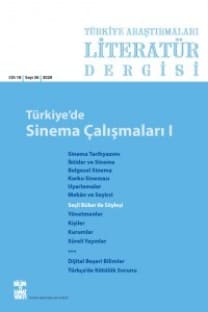Türkçe Matbu Hüsn-i Hat Literatürüne Toplu Bir Bakış
Osmanlı devrinde doruğuna erişen hat sanatı, tarihinin büyük bir bölümünde ustaçırak ilişkisine bağlı kalmış, meşk mecmuaları dışında yazılı kaynaklara ancak istisnai durumlarda başvurulmuştur. Ancak Cumhuriyet döneminde Lâtin harflerinin kabulü bu sözlü geleneği sekteye uğratmış, ağızdan ağıza aktarılan bilgilerin kâğıda geçirilmesini zorunlu kılmıştır. Bu makalede Osmanlı ve bilhassa Cumhuriyet devirlerinde basılan hat sanatına dair Türkçe kaynaklar gözden geçirilmektedir. Söz konusu kaynaklar arasında, geçmiş sanatçıların eserlerinden sonra en önemli olanları, hoca hattatların öğretim amacıyla hazırladığı meşkler, hurûfat kıt’aları ve müfredat murakkalarıdır. Bunların bir kısmı tıpkıbasım olarak yayınlanmış olmakla birlikte, genellikle en “mütekâmil” addedilen sanatçıların eserleri seçilmiş, bu arada hat tarihinin daha erken devirlerinin menzil taşları olanlar ihmal edilmiştir. Bunların yanı sıra bazı önemli hat risâleleri de yeni harflere çevrilerek yayınlanmıştır. Hüsn-i hat tarihi ve hattatların hayat hikâyeleri konusunda 16. yüzyıldan 20. yüzyıla kadar kaleme alınmış olan birçok risâle Osmanlı veyahut Lâtin harfleriyle yayınlanmıştır. Bu eserler, hat tarihi çalışmaları için olmazsa olmaz kaynaklar teşkil ederlerse de, artık sanatçıların hayat hikâyelerinin ötesine geçmenin, doğrudan sanat eserlerine yoğunlaşarak hat tarihinin geçirdiği evrelerin, bu evrelerin özelliklerinin somutlanmasının zamanı gelmiştir. Makalede hattat monografileri, belirli hat türlerinine yahut ibarelere yoğunlaşan kitaplar, mimari eserlerinde hat konusunu irdeleyen çalışmalar, sergi ve müzayede katalogları, bibliografyalar, paleografya, restorasyon, hat sanatının âlet ve gereçleri gibi konularıa adanmış kitaplar da bahis konusu edilmektedir. Bu eserlere hakim olan “connaisseur” tavrının sanat tarihçiliği ve sanat eleştirmenliğiyle tamamlanması gerekmektedir.
Anahtar Kelimeler:
Hat Sanatı, İslâm Sanatı, Yazı, Eğitim, Hayat Hikâyeleri
A Brief Survey of the Published Literature in Turkish on Islamic Calligraphy
Reaching its zenith during the Ottoman era, Islamic calligraphy was, during most of its history, bound by the master-apprentice relationship; except for exercise albums, written sources were the exception rather than the rule. However, the adoption of Latin script during the republican period interrupted this oral tradition and made it necessary to commit the orally transmitted knowledge to writing. This article reviews Turkish sources on calligraphy published during the Ottoman and particularly the republican periods. After the works of past masters. the most important sources are the exercises, alphabets, and ligature albums composed by master calligraphers. Although some have been published in facsimile, the choice of works has generally tended toward those of calligraphers considered most “evolved,” so that earlier milestones of the history of calligraphy have been neglected. In addition, some important treatises on calligraphy have also been published. Many treatises written between the sixteenth and twentieth centuries on the history of calligraphy, as well as biographical dictionaries of calligraphers, have been published in either Ottoman or Latin script. These treatises are sine qua non sources for studying the history of calligraphy, but it is time to go beyond artists’ biographies and focus on the works themselves, thus providing concrete analyses of the stages through which calligraphy has evolved, as well as the characteristics of these stages. Other books discussed in this article included calligraphers’ monographs, works focused on specific styles of calligraphy or textual content, calligraphy and architecture, exhibition and auction catalogues, bibliographies, and books devoted to paleography, restoration, and the implements of the art. It is necessary to complement the connaisseurship that dominates these works with the methodologies of art history and art criticism.
Keywords:
Islamic Calligraphy, Islamic Art, Writing, Education, Biographies,
- ISSN: 1303-9369
- Başlangıç: 2003
- Yayıncı: Bilim ve Sanat Vakfı
Sayıdaki Diğer Makaleler
Anadolu Türk Mimarisinde Taş Süsleme
Türkiye’de Türbe Mimarisi Araştırmaları
Geçiş Sürecinde Yiten Musiki: Sosyal Dönüşüm ve Osmanlı-Türk Musikisinden Varoluşsal Profiller
Hüseyin ETİL, Vefa Saygin ÖĞÜTLE
Cumhuriyet Dönemi Türk Plastik Sanatları
Cumhuriyet Dönemi Türk Musikisi Nazariyatı: Makaleler ve Tebliğler Bibliyografyası
Türkiye’de Sanat Tarihinde İlkler/Öncüler
Sanat Tarihi Yazımında Mimari Monografilere Dair İlk Örnekler (1857-1919)
